The Museum Collections
Introduction
I. History and Art Collection
1. Icons of the 14th – 19th centuries
icons of the 14th – 17th century
2. Jewelry art of the 14th – 20th century
jewelry art of the 14th – 17th century
jewelry art of the 18th – 19th century
the european silver 14th - 19th centuries
3. Small-size sculptures (works of metal, wood, bone)
XI – the beginning of the XX century
Small-size sculptures 11th – 17th century
Small-size sculptures 18th – early 20th century
enamel of Troitza masters 15-8th – early 20th century
5.Embroidery, lace, textiles of the 14th - early 20th century
gold and silver lace
6.Painting of the 18th – 21st centuries
painting of the 18th – 19th centuris
painting of the 20th – 21st centuris
II.Manuscripts and old printed books of the 14th – 17th century
IV.Lithography of the 18th – 19th century
V.Numismatics
VI.Medals of the 18th - early 20th century
VIII.Archeology collection
IX. Russian folk and applied and decorative art of the 17th – 21st c.
1. Artistic wood
folk carved and painted wood
wooden toys
house carving of Sergiev Posad
Khokhloma and Gorodets painting
2. Artistic textiles
embroidery and weaving
printed textiles and lace
Russian shawls
folk costumes
folk garments
printed cotton kerchiefs
|
The collection of wooden toys in the Sergiev-Posad museum(P.2) |
The image of a mass trade matryoshka, it’s underlined decorative character there was in second half of 1920-1930th years as a result of collective creative search. It underlined decorative character became some kind of the form of expression of representations about national beauty, harmony of life – wide-face, ruddy, smiling woman, with underlined roundish forms, dressed up in a celebratory suit and a patterned scarf.
The special interest is represented by a series of nested dolls and the doll heads executed by V.I.Sokolov (the artist, the developer of samples of toys, the manager of an is art-joiner's masterful workshop) and developed by it by request of local branch of Association of artists of revolutionary Russia (1925-1930). The considerable part of works of the artist had a satirical antireligious orientation that answered inquiries of a sociopolitical life of the young Soviet country.
|
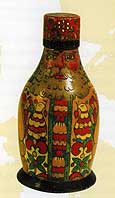
9. Matryoshka "Boyar". Author Vl. I.Sokolov. 1930.
|
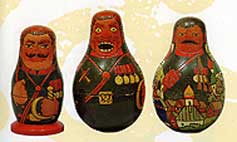
10. Matryoshka-tumbler toys. Athor V.I.Sokolov. Late 1920s - early 1930s.
|
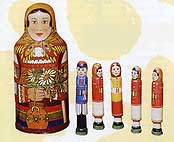
11. Matryoshka -packing «Matryoshka with skittles». Author V.I.Sokolov. 1933.
|
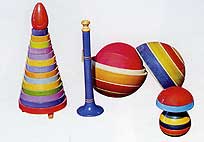
12. Toys «Pyramidion», "Pipe", "Sphere", "Mushroom". 1930s.
|
In 1947, the factory «Wooden toy» (since 1959 «Factory of toys and recreational goods»)was opened in Zagorsk. Its main task was association of masters - "home-workers", from families of hereditary toy-makers, kept unique experience, skills of art. Unique turning products of these masters: doll ware, children's sand sets, ïèðàìèäêè, fungi, spillikins are presented in the museum .
The structure of a collection of a museum included the nested dolls (matryoshka) made in the Zagorsk is art-industrial workshops in 1960-1980s.

13. Spillikins. Author P.P.Berezin. 1960th.
|
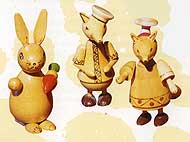
14. Toys turning. Author M.A.Ushatov. 1960th.
|
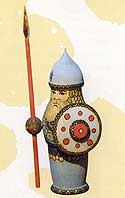
15. Case "Athlete". Author M.A.Ushatov (turning work) and A.V.Vlasov (painting). 1970s.
|
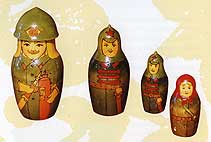
16. Matryoshkas "Fireman", "Red Army men". Author V.A.Sedova. 1970s.
|
Traditional nested dolls and the New Year's toys concerned to the last receipts of the collection that made at the “Sergiev-Posad Toys” Company, which masters continue to develop traditions of ancient crafts creatively.
With Sergiev-Posad toy-craft inseparably linked manufacture of toys in Bogorodsky village. The museum collection of Bogorodsky carved plastics one of the fullest in the country. It includes toys, sculptures, sculptural compositions and totals about four thousand exhibits.
In the beginning of 19th century toys were made in Bogorodsky "the most rough, imperfect design» and than they as a rule were painted in Sergiev Posad. An independent art style formed in Bogorodsky gradually.
The carving carried out quickly "rashly", by large and small cuts. Separate details of figures often do mobile for strengthening of emotional expressiveness of images or it’s entertaining. They strengthen on spring, using simple ways with application of buttons, sliding laths and balance.
Toys-sculptures devoted to a country life and the important events of the present was notes the sharp observation, virtuosity of execution. So, military victories of Russian army in 19th century was brought to Bogorodsky plastic images of military men in various uniforms, sets of tell-tales, horsemen, the scenes devoted to episodes of the Russian-Turkish company.
Thanks to a zemstvo the big distribution on a craft was received by foreign samples of toys with movement, which was successfully adapted by local carvers: well-known "smiths", «hens on a circle», "bears- splay-footed midge", and “the shepherd with the herd" and "soldiers” (toys on sliding laths).
Before the First World War leading carvers was united in Handicraft toys-carved artel, which in 1923 has renewed the work under the name «Bogorodsky carver». In 1930s Bogorodsky plastic was enriched by genre plots of is illustrative-narrative character, for example, the toy "Economy" of V.T.Polinov or executed on motives of fairy tales - «Hare’s izba» of A.F.Balaev & «Greyish goat» of G.M.Shishkin.
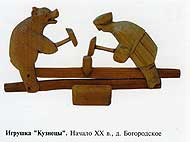
17. Toy "Smiths". Early 20th century. Bogorodsky village.
|
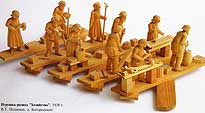
18. Toy "Economy". Author V.T.Polinov. 1938. Bogorodsky village.
|
|


